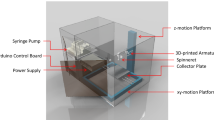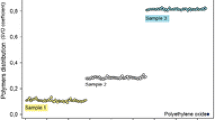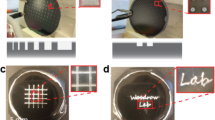Abstract
Confocal laser scanning microscopy with fluorescent markers and index matching has been used to collect three-dimensional (3D) digitized images of electrospun fiber mats and of a borosilicate glass fiber material. By embedding the fluorescent dye in either the material component (fibers) or pore space component (the index-matching fluid), acquisitions of both positive and negative images of the porous fibrous materials are demonstrated. Image analysis techniques are then applied to the 3D reconstructions of the fibrous materials to extract important morphological characteristics such as porosity, specific surface area, distributions of fiber diameter and of pore diameter, and fiber orientation distribution; the results are compared with other experimental measurements where available. The topology of the pore space is quantified for an electrospun mat for the first time using the Euler-Poincaré characteristic. Finally, a method is presented for subdividing the pore space into a network of cavities and the gates that interconnect them, by which the network structure of the pore space in these electrospun mats is determined.













Similar content being viewed by others
References
Baldwin CA et al (1996) Determination and characterization of the structure of a pore space from 3D volume images. J Colloid Interface Sci 181(1):79–92
Auzerais FM et al (1996) Transport in sandstone: a study based on three dimensional microtomography. Geophys Res Lett 23(7):705–708
Jones JR et al (2007) Non-destructive quantitative 3D analysis for the optimisation of tissue scaffolds. Biomaterials 28(7):1404–1413
Jaganathan S, Vahedi Tafreshi H, Pourdeyhimi B (2008) A realistic approach for modeling permeability of fibrous media: 3-D imaging coupled with CFD simulation. Chem Eng Sci 63(1):244–252
Levitz P (2007) Toolbox for 3D imaging and modeling of porous media: relationship with transport properties. Cem Concr Res 37(3):351–359
Turner ML et al (2004) Three-dimensional imaging of multiphase flow in porous media. Physica A 339(1–2):166–172
Kozeny J (1927) Ueber kapillare Leitung des Wassers im Boden. Sitzungsber Akad Wiss Wien 136(2a):271–306
Carman P (1937) Fluid flow through granular beds. Trans Inst Chem Eng 15:150–166
Fatt I (1956) The network model of porous media 1. Capillary pressure characteristics. Trans Am Inst Min Metall Eng 207(7):144–159
Valvatne PH, Blunt MJ (2004) Predictive pore-scale modeling of two-phase flow in mixed wet media. Water Resour Res 40(7):W07406
Chen S, Doolen GD (1998) Lattice Boltzmann method for fluid flows. Annu Rev Fluid Mech 30(1):329–364
Cancedda R et al (2003) Tissue engineering and cell therapy of cartilage and bone. Matrix Biol 22(1):81–91
Lowery JL, Datta N, Rutledge GC (2010) Effect of fiber diameter, pore size and seeding method on growth of human dermal fibroblasts in electrospun poly(ɛ-caprolactone) fibrous mats. Biomaterials 31(3):491–504
Luu YK et al (2003) Development of a nanostructured DNA delivery scaffold via electrospinning of PLGA and PLA–PEG block copolymers. J Controlled Release 89(2):341–353
Liu H et al (2004) Polymeric nanowire chemical sensor. Nano Lett 4(4):671–675
Chen L et al (2010) Multifunctional electrospun fabrics via layer-by-layer electrostatic assembly for chemical and biological protection. Chem Mater 22(4):1429–1436
Burger C, Hsiao BS, Chu B (2006) Nanofibrous materials and their applications. Annu Rev Mater Res 36(1):333–368
Pai C-L, Boyce MC, Rutledge GC (2011) Mechanical properties of individual electrospun PA 6(3)T fibers and their variation with fiber diameter. Polymer 52(10):2295–2301
Tomba E et al (2010) Artificial vision system for the automatic measurement of interfiber pore characteristics and fiber diameter distribution in nanofiber assemblies. Ind Eng Chem Res 49(6):2957–2968
Rutledge GC, Lowery JL, Pai CL (2009) Characterization by mercury porosimetry of nonwoven fiber media with deformation. J Eng Fibers Fabr 4(3):1–13
Jena A, Gupta K (2005) Pore volume of nanofiber nonwovens. Int Nonwovens J 14(2):25–30
Sampson W, Urquhart S (2008) The contribution of out-of-plane pore dimensions to the pore size distribution of paper and stochastic fibrous materials. J Porous Mater 15(4):411–417
Eichhorn SJ, Sampson WW (2010) Relationships between specific surface area and pore size in electrospun polymer fibre networks. J R Soc Interface 7:641–649
Ho ST, Hutmacher DW (2006) A comparison of micro CT with other techniques used in the characterization of scaffolds. Biomaterials 27(8):1362–1376
Stachewicz U et al (2012) Manufacture of void-free electrospun polymer nanofiber composites with optimized mechanical properties. ACS Appl Mater Interfaces 4(5):2577–2582
Sarada T, Sawyer LC, Ostler MI (1983) Three dimensional structure of Celgard® microporous membranes. J Membr Sci 15(1):97–113
Bagherzadeh R et al (2013) Three-dimensional pore structure analysis of nano/microfibrous scaffolds using confocal laser scanning microscopy. J Biomed Mater Res Part A 101A(3):765–774
Thibault X, Bloch J-F (2002) Structural analysis by X-ray microtomography of a strained nonwoven papermaker felt. Text Res J 72(6):480–485
Arns C et al (2002) Computation of linear elastic properties from microtomographic images: methodology and agreement between theory and experiment. Geophysics 67(5):1396–1405
Cox G, Sheppard CJR (2004) Practical limits of resolution in confocal and non-linear microscopy. Microsc Res Tech 63(1):18–22
Choong L et al (2013) Compressibility of electrospun fiber mats. J Mater Sci 48(22):7827–7836. doi:10.1007/s10853-013-7528-x
Jähne B (2005) Digital image processing. 6th Rev. and Extended Ed. Springer, Berlin, New York, xiii, 607 p
Toll S, Manson JAE (1995) Elastic compression of a fiber network. J Appl Mech 62(1):223–226
Heller W (1965) Remarks on refractive index mixture rules. J Phys Chem 69(4):1123–1129
Gooch JW (2011) Encyclopedic dictionary of polymers, 2nd edn. Springer, New York, NY
http://www.filmetrics.com/refractive-index-database/BSG/Borosilicate-Glass-Microscope-Slide. Accessed 25 August, 2014
Schindelin J et al (2012) Fiji: an open-source platform for biological-image analysis. Nat Method 9(7):676–682
du Roscoat SR, Bloch J-F, Thibault X (2005) Synchrotron radiation microtomography applied to investigation of paper. J Phys D Appl Phys 38(10A):A78
Pfeifer P et al (1991) Structure analysis of porous solids from preadsorbed films. Langmuir 7(11):2833–2843
Gelb LD, Gubbins KE (1999) Pore size distributions in porous glasses: a computer simulation study. Langmuir 15(2):305–308
Serra JP (1982) Image analysis and mathematical morphology. Academic Press, London
Ohser J, Nagel W (1996) The estimation of the Euler-Poincare characteristic from observations on parallel sections. J Microsc 184(2):117–126
Nagel Ohser, Pischang (2000) An integral-geometric approach for the Euler-Poincaré characteristic of spatial images. J Microsc 198(1):54–62
Vogel HJ (1997) Morphological determination of pore connectivity as a function of pore size using serial sections. Eur J Soil Sci 48(3):365–377
Kanit T et al (2003) Determination of the size of the representative volume element for random composites: statistical and numerical approach. Int J Solids Struct 40(13–14):3647–3679
Kanit T et al (2006) Apparent and effective physical properties of heterogeneous materials: representativity of samples of two materials from food industry. Comput Methods Appl Mech Eng 195(33–36):3960–3982
du Roscoat SR et al (2007) Estimation of microstructural properties from synchrotron X-ray microtomography and determination of the REV in paper materials. Acta Mater 55(8):2841–2850
Wang R et al (2012) Electrospun nanofibrous membranes for high flux microfiltration. J Membr Sci 392:167–174
Pham QP, Sharma U, Mikos AG (2006) Electrospun poly(ε-caprolactone) microfiber and multilayer nanofiber/microfiber scaffolds: characterization of scaffolds and measurement of cellular infiltration. Biomacromolecules 7(10):2796–2805
Rijke AM (1970) Wettability and phylogenetic development of feather structure in water birds. J Exp Biol 52(2):469–479
Tuteja A et al (2008) Robust omniphobic surfaces. Proc Natl Acad Sci 105(47):18200–18205
Acknowledgements
We are grateful to EMD Millipore Corporation for financial support of this work. We also wish to thank Dimitrios Tzeranis for the use of his MatLab code to determine fiber orientation distribution from SEM images, and Wendy Salmon for assistance in the use of CLSM.
Author information
Authors and Affiliations
Corresponding author
Additional information
Looh Tchuin (Simon) Choong and Peng Yi authors contributed equally to this work.
Electronic supplementary material
Below is the link to the electronic supplementary material.
Rights and permissions
About this article
Cite this article
Choong, L.T., Yi, P. & Rutledge, G.C. Three-dimensional imaging of electrospun fiber mats using confocal laser scanning microscopy and digital image analysis. J Mater Sci 50, 3014–3030 (2015). https://doi.org/10.1007/s10853-015-8834-2
Received:
Accepted:
Published:
Issue Date:
DOI: https://doi.org/10.1007/s10853-015-8834-2




